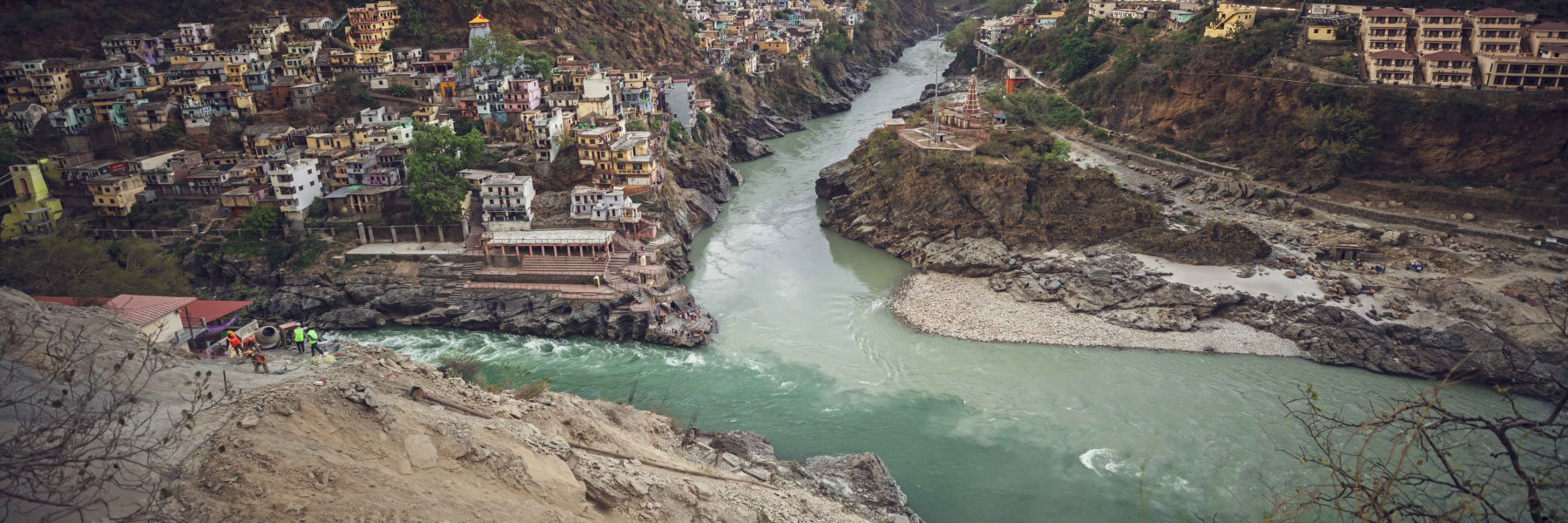
Sorry, we couldn't find anything that matches your search.
Destination

Famous Places to Explore in Hyderabad
A vibrant city with the imposing...

Raipur Tourist Places | Best Place to Visit
The stronghold of several erstwhile...

Ahmedabad
Declared as India's first UNESCO World...
#
Triveni Ghat
Situated at the confluence of three sacred rivers, the Ganga, the Yamuna and the Saraswati (that legends say once flowed here), Triveni Ghat is the most popular bathing ghat in Rishikesh. Before visiting the various temples, most pilgrims take a holy dip here. At dawn, the ghat is bustling with devotees offering prayers and bathing in the river, which according to Hindu mythology, washes away the sins of a person.
Evenings are stunning, with the spectacular arti (a ritual in which lamps are lit and prayers are offered to the river) called the 'Maha arti' being carried out at the ghat. This is accompanied by prayers and chantings. A multitude of lamps floating in the river during the arti present a spectacular view, leaving one in awe of the time-honoured traditions. There is a popular legend attached to Triveni Ghat and it is said that Lord Krishna visited this spot when he was hurt by an arrow shot by a hunter.

Neelkanth Mahadev Temple
Dedicated to Lord Shiva, who is known as Neelkanth, literally meaning the blue-throated one, the temple is a much-visited spot in Rishikesh. It stands at a height of 926 m on top of a hill across the Ganges and boasts a beautiful architecture.

Bharat Mandir
Near Triveni Ghat lies the Bharat Mandir, which is said to be the oldest temple in Rishikesh. It is said that it was built by sage Adi Shankaracharya on the day of Basant Panchami (festival to celebrate the arrival of spring) in 789 AD. The presiding deity of the temple is Lord Vishnu, whose idol has been carved out of a single black stone. Popularly called saligram, the idol has been placed in the inner chambers of the temple. On the day of Basant Panchami, the saligram is taken out for a holy bath in the sacred Mayakund, a small pond nearby. It is then carried in a grand procession through the city and later re-installed in the temple. Opposite to the temple is an old tree, which is a combination of three different trees, whose roots are entwined with each other, making it impossible to distinguish one from the other. These are the old banyan, peepal and bel trees. Many believe that these trees represent the holy trinity of Hinduism.
Lord Brahma, Lord Vishnu, Lord Shiva. Another attraction is a broken Buddha statue, obtained during excavations, which has been kept under the tree. It is believed to date back to the Ashoka period.

Karnaprayag
Karnaprayag is a picturesque spot on the way to the pilgrimage place of Badrinath. It is also one of the five confluences of the Alaknanda river and boasts a lush green landscape with the white foaming river enriching its beauty. Legends say this is the place where Karna, a central character in the Mahabharata, was cremated by Lord Krishna.

Dev Prayag
Scenic Dev Prayag is one of the panch prayags or the five sacred confluences of rivers in the Himalayas. The word 'Dev Prayag' literally means holy confluence. Here the River Bhagirathi (also known as Ganga) emerges from Gaumukh (terminus of Gangotri Glacier) and River Alaknanda from Alkapuri glaciers, to meet and form the holy River Ganges. One of the major attractions of Dev Prayag is the temple of Raghunathji.

Tera Manzil temple
The Triambakeshwar Temple or Tera Manzil Temple is a 13-storey temple, situated right opposite the Lakshman Jhula. Popular for its striking architecture, the temple offers panoramic views of the landscape from the top. The temple premises enshrines several deities under one roof. It is said that the temple was established by sage Adi Shankaracharya in 9th century AD. The structure is noted for its beautiful architecture, and Mahashivratri and Shravan Somvar festivities invite a lot of devotees from around the region.

Rudraprayag
Rudraprayag is named after Lord Shiva (Rudra) and is situated at the confluence of Rivers Alaknanda and Mandakini. It lies at a distance of about 34 km from Srinagar (Garhwal) and 141 km from Rishikesh. It is believed that this was the spot where to master the mysteries of music, Narad Muni worshipped Lord Shiva. It is said that Shiva appeared in his rudra avatar to bless Narad Muni. Rudraprayag holds significance as it has two prominent temples of Hinduism--the Jagdamaba Temple and the Shiva Temple. The town of Kedarnath, which holds great spiritual significance for devotees, is about 86 km from here.

Rishikund
A natural hot water spring, literally meaning the pond of the sage, Rishikund lies close to the popular Triveni Ghat. Legend has it that during ancient times, the holy Ganga stopped flowing, which created a drought in the region. To please Mother Ganga, devotees and saints performed yagya (a sacred fire ritual) and at their request Goddess Yamuna (believed to be Yamuna river that is considered the second-most sacred river in the country) herself appeared. It is said that she stayed here forever after that, removing all traces of the drought. Another folklore says that Rishikund was the place where Lord Rama used to bathe. The Raghunath Temple, dedicated to Lord Rama and Goddess Sita, stands beside Rishikund, and invites devotees from all around the region.







